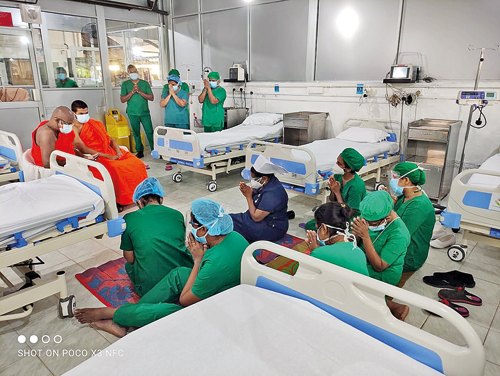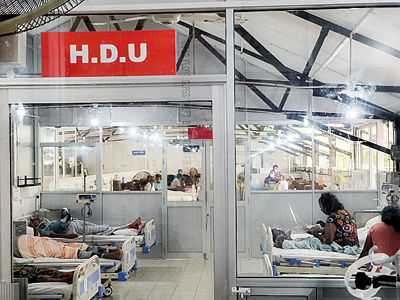News
At Panadura Covid ward, it was hell on earth, then a miracle happened

Thanks to the efforts of Sandya and Priyath, the two covid wards at the PBH are now equipped to treat covid patients in serious condition
Sometimes, the Panadura Base Hospital (PBH) COVID ward got so cramped that doctors couldn’t reach patients at the far end for fear of stepping on someone. There were patients on, under and in-between beds.
The first wave had been mild. The hospital wasn’t a designated COVID centre. So the dedicated Bhikshu ward held infected patients pending transfer. During the second wave, medical staff realised they needed more space and mixed surgical ward was partitioned into male and female sections. But the 18 beds were never full.
The third wave hit everyone hard. The patients kept coming, a doctor said, and the ward was creaking with the load. Meanwhile, the Government instructed all hospitals to manage cases in-house until beds freed up at specialised treatment centres.
By April 25-26 , PBH took around 50 patients a day and most were symptomatic. Those without symptoms were also accepted as home-treatment wasn’t yet allowed. The ward was poorly ventilated and humid. It was meant for 18 but it had gone well above.
 “There were patients on the floor, even under the beds,” the doctor said, requesting anonymity. “There was a point when they couldn’t even lie down and had to sleep seated. Some needed more care and monitoring but it was so packed we couldn’t reach them.”
“There were patients on the floor, even under the beds,” the doctor said, requesting anonymity. “There was a point when they couldn’t even lie down and had to sleep seated. Some needed more care and monitoring but it was so packed we couldn’t reach them.”
It was also dangerous for medical staff. The viral load was high. The ward also couldn’t be modified–even to fix an exhaust fan–because workmen didn’t dare go inside. The intensive care unit (ICU) wasn’t meant for COVID patients. And there was no high dependency unit (HDU).
“We had a road accident victim who tested positive for COVID after arriving at the hospital but we couldn’t transfer him to the ICU as it would mean shifting all the others out,” the doctor recalled. “He had severe brain damage and we hooked him up to a ventilator in the ward. He passed away after two days.”
Dealing with the pandemic in such a situation was terrible, he confessed. “Every day, it seemed worse. More than physically, medical employees were emotionally and mentally drained. It was hell on earth.”
The nurses had a particularly gruelling experience. Patients were dying. Some could have been saved but couldn’t be tended to in time.
It wasn’t possible to introduce procedures amidst the mayhem. All they could do was administer oxygen but with increasing numbers it was risky to keep cylinders inside the packed ward. So these were positioned outside with tubes sent through the windows.
It all changed with an appeal for help. Sandya Salgado and her husband, Priyath, are Panadura natives who, along with others, have assisted the hospital for years. The marketing communications professional received a request for gloves and personal protective equipment (PPE). She messaged a doctor and asked about the situation.
He replied: “I wish I could show you how people are suffering inside this ward. We have never ever seen so many people gasping for air like this. Just want to let you know that your efforts will save many, many lives in the next few months.”
Sandya turned to social media. On May 17, she published on Facebook their goal to turn two wards at PBH into an HDU because of escalating patient numbers and deaths. She called it a “herculean fundraising overdrive” and begged for funds to buy high flow nasal cannula therapy machines, each costing Rs 1.3mn. She also wrote on LinkedIn and created a flyer.
“I have secured five,” she wrote. “I want to keep going until we get at least 25. I know it’s a crazy target. But I know we can come together to achieve this.”
By the next day, there were enough funds for ten machines. The goalpost shifted to other essential lifesaving equipment such as continuous positive airway pressure (CPAP) and bi-level positive airway pressure (Bi-PAP) therapy machines; multi-para monitors, oxygen concentrators, ventilators, infusion and syringe pumps.
Within eight days, more than Rs 40mn was raised. On Vesak Day, 26 May, there was a small opening–no politicians, no ribbon-cutting–and COVID patients were shifted to the refurbished wards. The project was “one hundred percent people-funded”, Mrs Salgado said, with people donating in cash and kind.
The Rotary Club of Colombo Regency donated a wall oxygen system and other high-valued machines. A group of friends from Panadura reached out to their contacts. Other groups, including one called ‘Spread a Little Love’, joined hands. The appeal went international. The corporate sector and trust funds also pitched in.
“All this was done within just a week,” she updated on Facebook. “This just shows the power of the people, rallying round a worthy cause with ZERO political patronage.”
“As for the donors, there was no expectation of any tamashas,” she said. “No ribbon cutting, no posing for pictures with donations, no plaques. Just making sure the equipment reached the hospital to start the ward.”
Every cent has been accounted for and a detailed report is to be released. The integrity and honesty of the organizers coordinators and the genuineness of the cause are key factors in the success of such projects, Mrs Salgado said.
Some donations were Rs 200 rupees. The average was between Rs 5000-10,000. And it went up from there. Everyone wanted anonymity. “They knew they wouldn’t get their face or name published,” she reflected. “They were giving to a cause they truly believed in.”
It was a round-the-clock operation: calls, zoom meetings, conversations with hospital staff to ensure there was no duplication, giving clarifications to donors, ordering equipment, ensuring delivery and so on. “We moved mountains,” Mrs Salgado said.
The Regional Director of Health Services approved Rs 3mn to build the structure and portioning. The engineer started work before the money was even passed, saying he will bear the cost if it isn’t paid. The office also loaned their vehicles whenever necessary.
The challenge was to decide on priorities, a medical officer said, sharing his experience of the project. A list was drawn up of equipment and a special hospital committee decided what equipment was urgent. “Whatever we asked for, we got,” he smiled. “It was like we won a lottery. We went from minus to plus, plus, plus and everybody is happy.”
The new ward is almost full now. Doctors know it will reach capacity soon. But they are finally confident of providing a quality service that was unimaginable before. And more work is in the pipeline.

